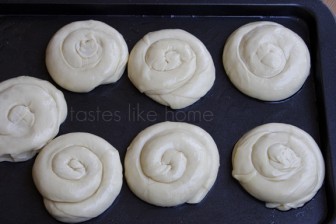Hi Everyone,
Last week, in this 2-part series looking at the required water content for creating dough, I explained that there was no definitive answer as to how much water is needed to make dough. It all depends on several factors, such the type of water, the temperature of the water, the type of liquid being used, the altitude of your location, other ingredients in the mixture and how the ingredients were measured, to name a few.
In concluding the series, I’m suggesting some ways to go about creating the dough and discussing the importance of kneading the dough for the time prescribed in recipes and the why it is necessary to let the dough rest and relax.
In my first column for this year, “Feel-Up Your Food”, I remarked how Dave Martins and I have been having exchanges about this whole issue of creating dough, kneading and knowing when it is kneaded to the right stage. In the spirit of those discussions, let me try my best to offer some advice with the hope of making us all better dough makers.

To create dough, here is what you are essentially doing – mixing dry and wet ingredients to come together as a unit. Once the wet and dry ingredients are combined, you are then going to knead, work that mass to so that it becomes pliable. In other words, you want it to be able to stretch and be shaped so that when the final product cooks up, literally, its look and texture meets your expectations.

● Do not add all of the water to the flour at the same time. Use this as a general guide: if a recipe calls for 1 cup of water add ¾ cup and start working the dough and add the rest as you go along if needed, slowly and steadily. If it calls for 2 cups of water, add 1½ cups and then add the rest if needed. If it calls for 3 cups water add 2 1/3 cup, if 4 cups water, add 3¼ cups. Like I said, use this as a general guide. The bottom line is not to add all of the water at the same time, this allows for more to be added if it is needed.
● Keep a note pad and pen handy each time so that you can begin to jot down how much water you use each time until you come up with a formula that works for you. It really is something that is best learnt by doing, by experience.
● Make a well in the center of the flour and pour in the water, then start mixing the flour with the water. Sometimes I start mixing with a fork and then switch to using my hands and then there are times that I exclusively use my hands. When the dough begins to leave the sides of the bowl (at this stage the dough may still have a few loose bits but it has the amount of liquid needed), turn the contents on to a floured work surface and knead the dough with your hands, dusting ever so lightly. The more you knead, the less sticky the dough will become and you will eventually see that you do not need to dust the surface with flour.
● When the dough first comes together in the bowl, if you poke it with your finger you will notice that it immediately springs back, no indentations can be made. At this stage the dough has not been properly formed in a cohesive manner. However, as you continue to knead the dough, you will notice that you can poke it and its reaction time slows down and dents can be made.
● The reason dough needs to be kneaded or worked once it comes together is so that the gluten in the mixture can develop and become elastic, it can stretch and contract. The dough can now change its shape under pressure (stretching) and yet move back to its original position (contact). Gluten is the protein that gives wheat its liveliness and makes raised breads possible.
● The more you knead, the denser the texture of the finished product; this is because the gluten is being worked over and over until it forms tight curls or web. Also pay attention to the time indicated in a recipe for kneading. Yes, there is such a thing as over-kneading that results in a coarse-texture crumb. The crumb is everything inside the crust of a baked good. For example, when you cut a slice of bread, see the white part surrounded by the crust? That is the crumb. When you slice cake that whole inside is the crumb.
● To knead, fold the dough over towards you then press it away from you with the floured heel of your hand. Give the dough a quarter turn, fold and press away from you again and keep repeating. When the dough is finished kneading at the time specified, it should be elastic and satiny.
● The importance of letting the dough “rest” after kneading cannot be overstated nor should it be underestimated. Resting the dough is really allowing the gluten to relax. This relaxation allows the elasticity to strengthen. Elastic dough that has never been relaxed would never be formed into the many shapes of raised dough. The roti(s) would never be tender and the bakes would never rise. The protein molecules in the dough need to gradually relax into a flatter, more malleable mass.
● One of the questions Dave had was why cover the dough with cloth. The dough can be covered with a kitchen towel (cotton or flour bag variety); these types are preferred because they are porous enough to allow the dough to “breathe” without altering the temperature of the dough. Yes, for decades we have been doing this out of tradition or a practise we grew up seeing but there is a certain kind of science behind it. You can also cover the dough or the bowl that contains the dough with plastic wrap, greased plastic wrap or even greased aluminium foil. Covering the dough is to prevent it also from forming a “skin”. This is where the top coating of the dough dries out. An added measure to prevent this, even when covering the dough is to rub a little oil all over the dough. I never leave dough to rest covered without a dab of oil.
● If your dough is to make roti or some other type of flat bread or bakes, you can use the cover that came with whatever bowl or container you are using. But if your dough is to be risen, then be sure to cover it with something that allows the dough room to grow, such as a cotton or flour bag type kitchen towel or plastic wrap. Alternately, if you have a bowl or container much larger than the one in which the dough is, then use it as the cover, you will have to ensure that it does not allow in air or draft (but it must be roomy. Dough set to rise needs a temperature-consistent environment. Here in the Caribbean and in other tropical climates we don’t have problems getting our dough to rise, unless the yeast we are using is no good. If you live in places with fluctuating temperatures and different climate seasons then creative ways have to be found. Some people turn on a heater; others put the dough in pilot-lit ovens, some in microwaves and others make do-it-yourself airtight boxes.
I hope that I’ve been able to help you to overcome some of your fears of working with dough. I hope that you are encouraged to go into your kitchen renewed and ready to take another stab at kneading dough. I hope that some of the advice will help you to master your already developed knowledge of creating dough.
Many of you will still have questions, I know. Please write to me and let’s try to help each other work it out. Or some of you may have tips and suggestions that we can all benefit from. Please share. I can be reached at: Cynthia@tasteslikehome.org
Cynthia




